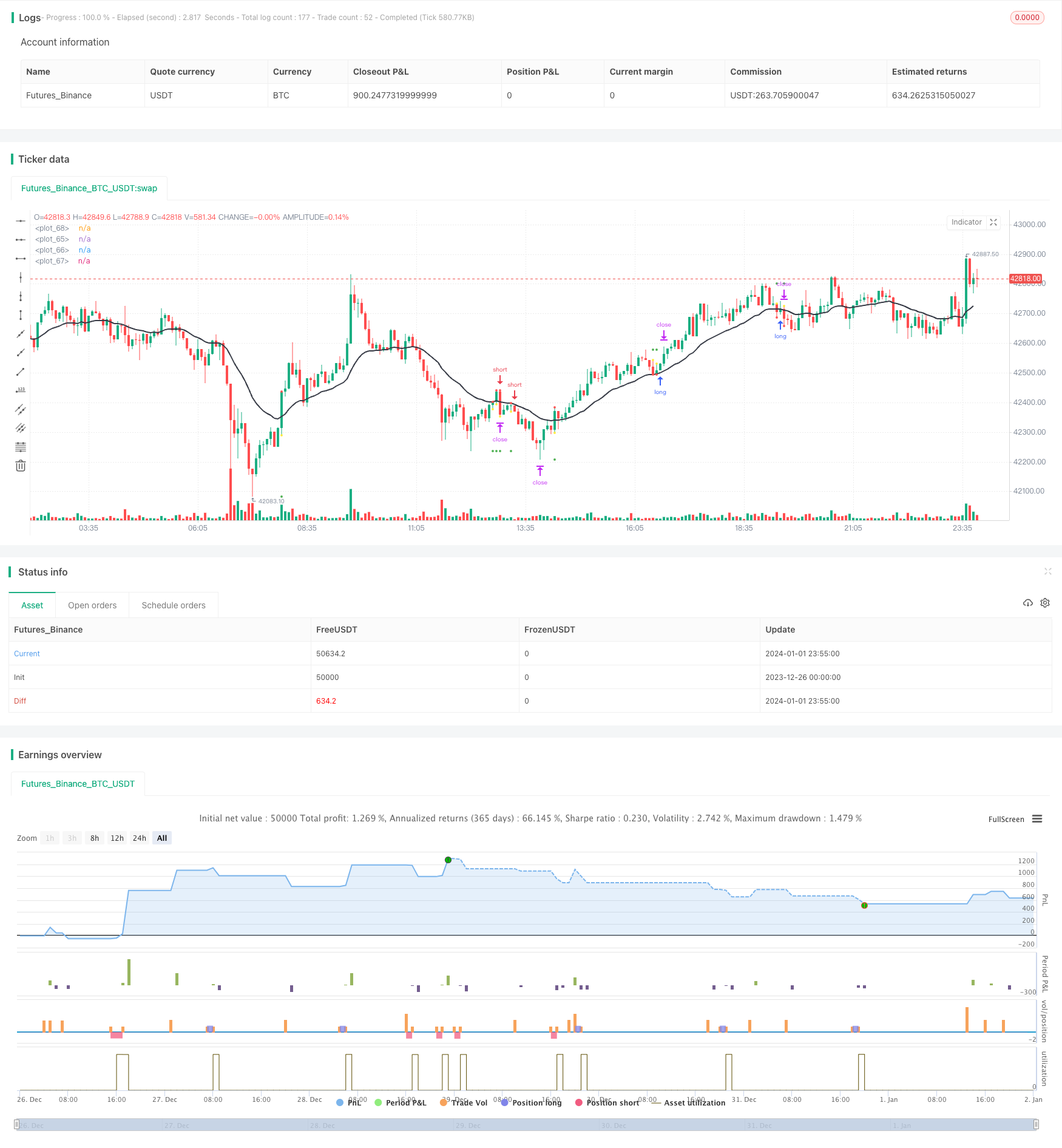
概述
双EMA黄金交叉震荡追踪策略是一个利用EMA指标识别趋势,并在震荡行情中进行追踪的策略。该策略综合了趋势跟踪和震荡捕捉的思路,在强势行情中进行长线追踪,在震荡行情中进行短线交易,以期获得较好的收益。
策略原理
该策略使用20周期的EMA作为判断趋势的指标。当价格上穿EMA时,认为行情开始上涨;当价格下穿EMA时,认为行情开始下跌。
在价位上穿EMA时,以20周期highest的最高价作为止盈位,以自价格上穿EMA后low的最低价作为止损位,做多进入;在价位下穿EMA时,以20周期lowest的最低价作为止盈位,以自价格下穿EMA后high的最高价作为止损位,做空进入。
同时,策略还会判断ADX是否大于30。只有在趋势足够明确时,即ADX高于30时,才会进行交易。这可以避免在震荡行情中出现止损。
在持仓过程中, trail stop会根据市场实时情况来调整,以锁定更多利润。
优势分析
该策略结合了趋势跟踪和震荡交易的优点,既可以在趋势行情中获得较大利润,也可以在震荡行情中获得较稳定收益,具有较强的适应性。
EMA的应用也使得策略的参数较少,降低了过度优化的风险,从而保证了策略的稳定性。
风险分析
该策略主要的风险在于震荡加剧时可能出现较多的止损。这时ADX的作用就凸显出来了。当ADX值较低时,会关闭交易,避免在无明确趋势时的损失。
此外,合理设置止损点也是关键。止损点设置过大,可能增加单笔损失;止损点设置过小,则可能过于灵敏,增加止损概率。这里需要在盈利目标和止损风险之间找到平衡。
优化方向
该策略可以从以下几个方面进行优化:
EMA周期的选择。可以测试更多的EMA周期参数,找到最佳参数组合。
ADX的参数可进行优化。ADX周期和ADX的阈值都可以尝试不同设置。
止盈止损算法可以改进,如引入动态止盈止损。
可以考虑加入其他指标进行组合,如KDJ、MACD等,形成多指标验证策略。
总结
双EMA黄金交叉震荡追踪策略总的来说是一个非常实用的策略。它融合了趋势策略和震荡策略的特点,既可以用于长线追踪,也可以用于短线交易。通过参数优化和组合指标验证,该策略的效果还可进一步提升。它适用于对市场有一定研判能力的投资者。
/*backtest
start: 2023-12-26 00:00:00
end: 2024-01-02 00:00:00
period: 5m
basePeriod: 1m
exchanges: [{"eid":"Futures_Binance","currency":"BTC_USDT"}]
*/
//@version=2
strategy("Linda Raschke's Holy Grail", shorttitle="RHG", default_qty_type = strategy.percent_of_equity, default_qty_value = 100, overlay = true)
adxlen = input(14, title="ADX period")
adxMin = input(30)
dilen = adxlen
f_highest(_src, _length)=>
_adjusted_length = _length < 1 ? 1 : _length
_value = _src
for _i = 0 to (_adjusted_length-1)
_value := _src[_i] >= _value ? _src[_i] : _value
_return = _value
f_lowest(_src, _length)=>
_adjusted_length = _length < 1 ? 1 : _length
_value = _src
for _i = 0 to (_adjusted_length-1)
_value := _src[_i] <= _value ? _src[_i] : _value
_return = _value
dirmov(len) =>
up = change(high)
down = -change(low)
plusDM = na(up) ? na : (up > down and up > 0 ? up : 0)
minusDM = na(down) ? na : (down > up and down > 0 ? down : 0)
truerange = rma(tr, len)
plus = fixnan(100 * rma(plusDM, len) / truerange)
minus = fixnan(100 * rma(minusDM, len) / truerange)
[plus, minus]
adx(dilen, adxlen) =>
[plus, minus] = dirmov(dilen)
sum = plus + minus
adx = 100 * rma(abs(plus - minus) / (sum == 0 ? 1 : sum), adxlen)
emaLength = input(20)
curEma = ema(close, emaLength)
highPeriod = input(20)
d = na
takeProfitLong = highest(high, highPeriod)
stopLossLong = f_lowest(low, barssince(low >= curEma))
if strategy.position_size == 0
if adx(dilen, adxlen) <= adxMin or high < curEma
strategy.cancel("Long")
if adx(dilen, adxlen) > adxMin and low < curEma and high > curEma and curEma > curEma[highPeriod / 2] and curEma > curEma[highPeriod] and takeProfitLong > high
strategy.order("Long", strategy.long, stop = high)
strategy.exit("Exit", "Long", limit = takeProfitLong, stop = stopLossLong)
d := high
takeProfitShort = lowest(low, highPeriod)
stopLossShort = f_highest(high, barssince(high <= curEma))
if strategy.position_size == 0
if adx(dilen, adxlen) <= adxMin or low > curEma
strategy.cancel("Short")
if adx(dilen, adxlen) > adxMin and high > curEma and low < curEma and curEma < curEma[highPeriod / 2] and curEma < curEma[highPeriod] and takeProfitShort < low
strategy.order("Short", strategy.short, stop = low)
strategy.exit("Exit", "Short", limit = takeProfitShort, stop = stopLossShort)
d := low
strategy.close("Exit")
plot(d == high ? stopLossLong : d == low ? stopLossShort : na, style = circles, linewidth = 4, color = red)
plot(d == high ? takeProfitLong : d == low ? takeProfitShort : na, style = circles, linewidth = 4, color = green)
plot(d, style = circles, linewidth = 4, color = yellow)
plot(curEma, color = black, linewidth = 2)
// === Backtesting Dates ===
testPeriodSwitch = input(false, "Custom Backtesting Dates")
testStartYear = input(2018, "Backtest Start Year")
testStartMonth = input(3, "Backtest Start Month")
testStartDay = input(6, "Backtest Start Day")
testStartHour = input(08, "Backtest Start Hour")
testPeriodStart = timestamp(testStartYear,testStartMonth,testStartDay,testStartHour,0)
testStopYear = input(2018, "Backtest Stop Year")
testStopMonth = input(12, "Backtest Stop Month")
testStopDay = input(14, "Backtest Stop Day")
testStopHour = input(14, "Backtest Stop Hour")
testPeriodStop = timestamp(testStopYear,testStopMonth,testStopDay,testStopHour,0)
testPeriod() =>
time >= testPeriodStart and time <= testPeriodStop ? true : false
isPeriod = testPeriodSwitch == true ? testPeriod() : true
// === /END
if not isPeriod
strategy.cancel_all()
strategy.close_all()